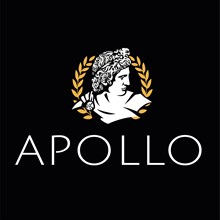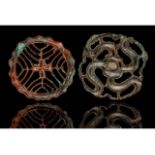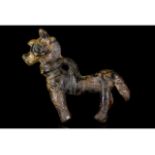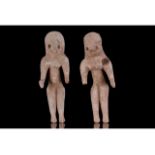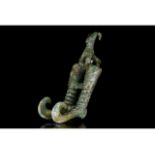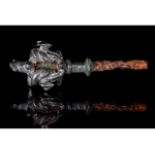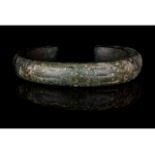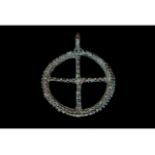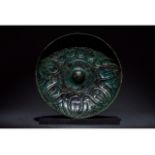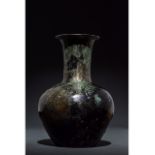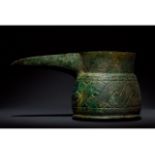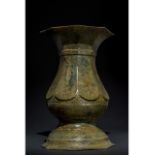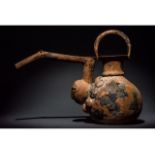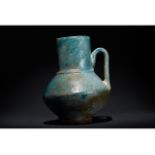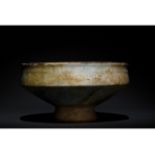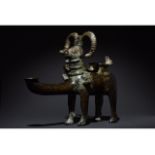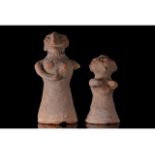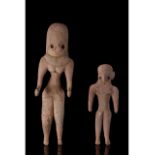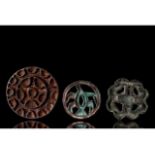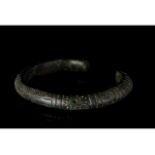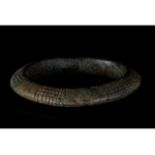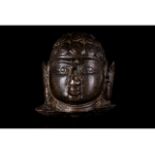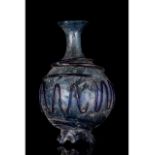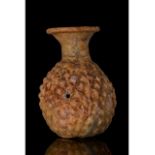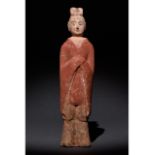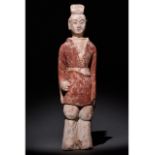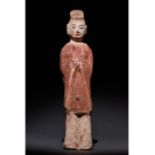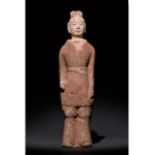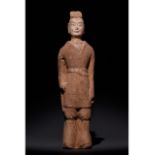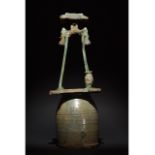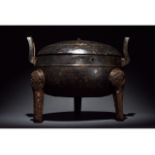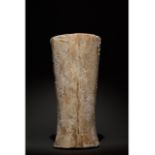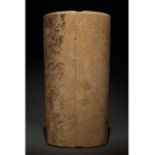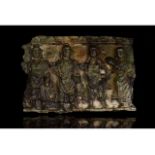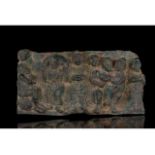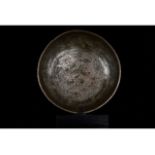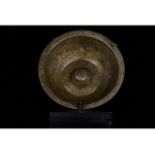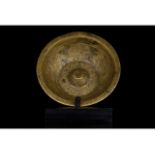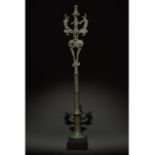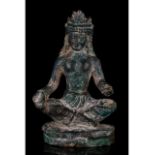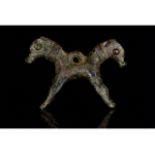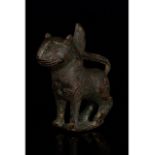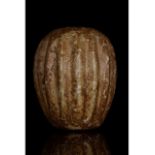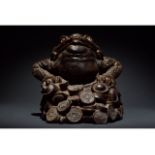Refine your search
Estimate
Category
- Chinese Works of Art (55)
- Greek, Roman, Egyptian & Other Antiquities (38)
- Sculpture (12)
- Islamic Works of Art (10)
- Arms, Armour & Militaria (8)
- Glassware (6)
- Bank notes (5)
- Jewellery (5)
- Metalware (4)
- Vintage Fashion (3)
- Ceramics (2)
- Collectables (2)
- Indian Works of Art (2)
- Salvage & Architectural Antiques (2)
- Scientific Instruments (2)
- Asian Art (1)
- Books & Periodicals (1)
- Coins (1)
- Furniture (1)
- Kitchenalia (1)
- Taxidermy & Natural History (1)
- Textiles (1)
Filtered by:
- Creator / Brand
- List
- Grid
A subscription to the Price Guide is required to view results for auctions ten days or older. Click here for more information
3rd millennium BC. Indus Valley Culture. A mixed pair of openwork bronze seals comprising: 1) a circular stamp arranged around a radiating cross m...
LARGE BRONZE AGE ANIMAL FIGURE
c. 1200 to 800 BC. Western Asiatic, Luristan culture. An attractive cast bronze figurine of a quadruped beast with short ears, large eyes and styl...
C. 3rd millennium BC. Indus Valley Civilisation. A pair of light reddish-brown coloured handmade terracotta idols of characteristically abstract f...
c. 1200 to 800 BC. Western Asiatic, Luristan culture. An attractive cast bronze furniture fitting. The piece comprises two curled feet which suppo...
c. 2000-700 BC. Western Asiatic, Luristan Culture. An unusual bronze sceptre with a central ceremonial mace head comprising horned animals within ...
c. 800-600 BC. Western Asiatic, Luristan Culture. Heavy cast bronze bracelet with a D-shaped section and sheer terminals, now patinated in stunnin...
c. 1200 to 800 BC. Western Asiatic, Luristan Culture. A large bronze age wheel pendant comprising circular hoop and crossed spokes. The wheel and ...
600-330 BC. Western Asiatic, Achaemenid period. This bronze phiale or shallow bowl comprises a flaring rim, incurved walls and flattened base. Ext...
C. 224 to 651 AD. Sassanian. A rare bronze vessel with a flaring rim, slightly tapering neck, globular body and flat base. The Sassanian empire wh...
c. 1200 to 800 BC. Western Asiatic, Luristan culture. Bronze vessel with tapering neck, slightly globular body, flat based and elongated, beak-lik...
C. 1100 AD. Seljuk. A rare bronze vase with a flaring octagonal rim, constricted neck, piriform body and a high applied foot. The body is decorate...
c. 1200 to 800 BC. Western Asiatic, Luristan culture. Bronze vessel with bucket-style strap handle, wide rim, constricted neck, globular body, rin...
C. 1000 AD. Nishapur. A beautiful turquoise glazed terracotta vessel with a cylindrical neck, biconical body, ring foot and grooved, ear-shaped ha...
SELJUK GLAZED TERRACOTTA BOWL
C. 1100 AD. Seljuk. A gorgeous turquoise glazed bowl with an out-turned rim, straight wall and sloping bottom which sits atop a ring base. In the ...
C. 2nd-1st millennium BC. A spectacular ram-shaped bronze oil lamp. The ramp stands foursquare, looking forward. Large, curved horns, project from...
C. 3rd millennium BC. A pair of light reddish-brown coloured handmade idols of characteristically abstract form with highly stylised features, inc...
C. 3rd millennium BC. A pair of light reddish-brown coloured handmade terracotta idols of characteristically abstract form with wide hips, careful...
C. 3rd millennium BC. Indus Valley Culture. A mixed group of three bronze seals comprising: 1) a disc with two registers of semi-circles arranged ...
C. 1000 BC. Western Asiatic. A gorgeous heavy bronze bracelet with a D-shaped section and sheer terminals bearing an attractive series of abstract...
C. 1000 BC. Western Asiatic. An attractive heavy bronze bracelet with a D-shaped section and confronted terminals. The bracelet's band is decorate...
400-500 AD. Late Gandharan. An excellent example of a Gandharan bronze head, originally part of a larger statue depicting Buddha with the characte...
SASSANIAN DECORATED GLASS FLASK
C. 224 to 651 AD. Sassanian. A decorated glass flask. This beautiful flask made of aquamarine glass comprises a flaring rim, narrow, cylindrical n...
SASSANIAN RIBBED GLASS FLASK
C. 224 to 651 AD. Sassanian. A glass flask with net pattern. The vessel comprises an out-turned, folded rim, an in-sloping neck and piriform body....
C. 500 AD. Chinese Northern Wei Dynasty. An elaborately crafted male attendant figure dressed in a rich red tunic and brown trousers; from the rea...
C. 500 AD. Chinese Northern Wei Dynasty. A carefully crafted male attendant figure dressed in a rich red tunic and brown trousers; a cream sash or...
C. 500 AD. Chinese Northern Wei Dynasty. An elaborately crafted male attendant figure dressed in a rich red tunic and light brown trousers; from t...
C. 500 AD. Chinese Northern Wei Dynasty. A carefully crafted male attendant figure dressed in a pinkish-red tunic and brown trousers; a cream sash...
C. 500 AD. Chinese Northern Wei Dynasty. A carefully crafted male attendant figure wearing in a brown tunic and trousers; a cream sash or belt run...
C. 1368-1644 AD. Ming Dynasty. An exceptional turquoise glazed terracotta well comprising a characteristic shrine gate sitting atop bell-shaped we...
C. 206 BC-220 AD. Han Dynasty. A bronze and iron tripod, generally known as a ding. The object comprises a hemispherical bronze body with an in-st...
c. 3000-2000 BC. Bactrian. A beautiful example of a column idol (sometimes called a pillar idol) of waisted cylindrical form with flaring base, th...
c. 3000-2000 BC. Bactrian. A beautiful example of a column idol (sometimes called a pillar idol), carved from a mottled pale-orange stone with whi...
100-300 AD. Gandharan bronze frieze plaque with Buddha. Depicted are four standing figures wearing simple monastic robes, with their right hands r...
100-300 AD. Gandharan bronze frieze plaque with Buddha and his followers. Buddha, standing in the centre and wearing a simple monastic robe, is fl...
ca. 1800 - 1900 AD Islamic. Beautiful flat Islamic silvered bronze bowl. The decoration, which covers the whole of the outer surface, consists of ...
ISLAMIC BRONZE MAGICAL BOWL
19th century. Iran or Central Asia. Qajar style. Persian Qajar Dynasty chiselled brass "magic" bowl. Rounded form on short tapering base, the cent...
ISLAMIC BRONZE MAGICAL BOWL
19th century. Iran or Central Asia. Qajar style. Persian Qajar Dynasty chiselled brass "magic" bowl. Rounded form on short tapering base, the cent...
c. 2000- 7th century BC. Western Asiatic. Western Asiatic Master of Animals Sceptre . A central tube terminating into a human head. Flanked by ani...
GANDHARA BRONZE FIGURE OF BUDDHA
100-300 AD. Gandharan (or later) bronze sculpture of Buddha. He sits high upon a throne, holding the palm of his left hand in the air and the righ...
c. 1200 to 800 BC. Western Asiatic, Luristan culture. Attractive cast bronze figure of a four-legged, two-headed animal with flattened ears, large...
SELJUK BRONZE ANIMAL FIGURE
c.10th-12th century AD. Seljuk. A beautiful cast bronze figure depicting a feline standing in profile, its captivating visage comprised of a large...
MESOPOTAMIAN STONE MACE HEAD
c. 2900-2350 BC. Early Dynastic period. Mesopotamia. This carved stone mace head with diagonal flutes is among the most graceful weapons to surviv...
CHINESE "MONEY FROG"
A lovely iron sculpture from China depicting the legendary three-legged money toad, also called Jin Chan wealth toad. The Jin Chan (Chinese: 金蟾; p...
